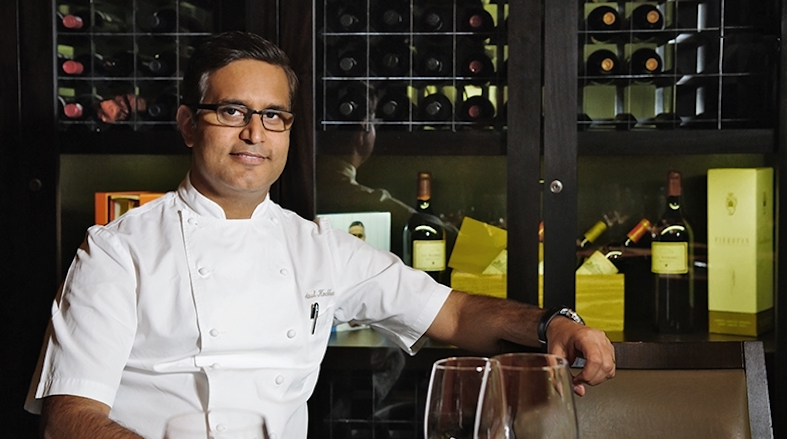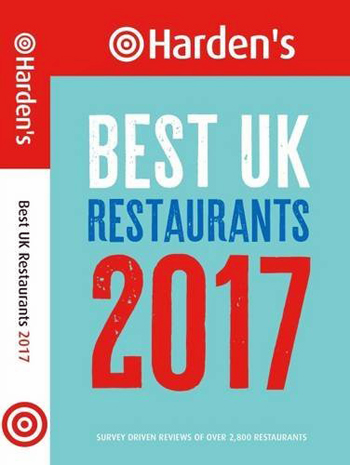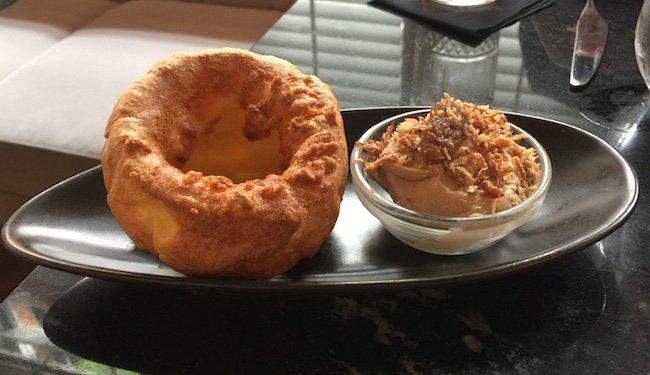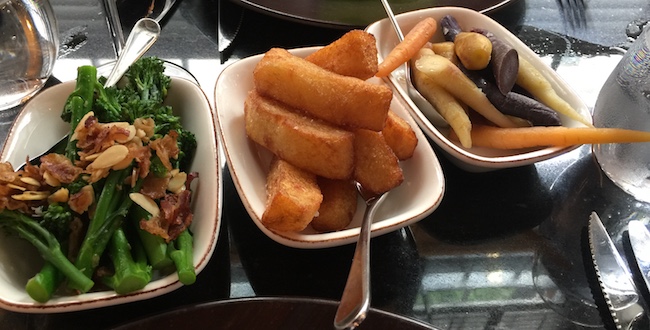In 2001, Atul Kochhar was the head chef at Tamarind, when it became the first restaurant of its kind to be awarded a Michelin star, within a year he had moved to establish his own eaterie (the now iconic) Benares, which achieved the same accolade within a few years of opening. Chef Kochhar has progressively and carefully expanded his business interests, while maintaining a dedication to his family values alongside an astute understanding of the demands of an ever evolving customer base. The interview took place in the bar at Benares restaurant in May 2017.

Tell us some background as to how you originally became a chef.
My grandfather was a baker and my father had a small catering business so I grew up looking at- and experimenting with- food! At a time where my friends were aspiring to go to engineering or medical college, I instead wanted to go to a school of hotel management, and luckily, my father was very supportive of that ambition; my father thought I was very bright and could achieve a great deal in the industry but should get the qualifications behind me first. That proved to be great advice.
How did your time at Tamarind evolve?
As a young man, I was working in India at the world-renowned Oberoi Hotels. They have their own training school into which they take a maximum of 12 to 15 students each year. Considering the country might have hundreds of thousands of school graduates each year, competition is high and the entrance to that training scheme is something of a lottery. I had the privilege of being a part of that programme.
Whilst cooking at one of the Oberoi Hotels, the owners of Tamarind were regulars there, I was asked by Mr Oberoi himself if I would ‘meet with his friends as they would like to have a chat with me’; he was referring to the owners of Tamarind. Nothing more was said so I was worried that I was about to get a telling off but in actual fact there was a job offer! I was 24 years old at the time and excited about the idea of getting out and traveling so I said yes. It was something that I had wanted, either travelling to the US or Australia, to further my training and career so when Tamarind in the UK came up it felt right.
I joined as Head Chef and was Head Chef for the full nine years; in 2001 Tamarind was the first restaurant of its kind to be awarded a Michelin star.
Diagonally opposite was Marco Pierre White at Mirabelle and across the way, the old Curzon building housed Jean-Cristophe Novelli, while just down the road was the Roux’ dynasty at Le Gavroche; these chefs were like idols who I might have spoken to occasionally, it was completely surreal to suddenly have achieved a Michelin star with Tamarind. I loved every minute of it!
How did Benares come about and how did your wider business interests develop?
After achieving the Michelin Star in 2002, I admired people like Gordon Ramsay and Marcus Wearing in how they had developed business opportunities. The natural next step was to ask my employers if they were considering growing their restaurant portfolio and whether I could have some equity in that process. They explained that it was purely a family venture so I asked if they wouldn’t mind if I stepped away from Tamarind to start up something of my own.
I quickly found a couple of partners who helped me to set up Benares. I currently employ about 58 people at the restaurant. In the kitchen there are 14 chefs, two shy of where we want to be (getting the right chefs is really tough in the market at the moment). Front of house, we have about 28 staff, this is because the venue is quite spread out with 4 private dining rooms, including a chef’s table, a lounge and bar, the main restaurant and a reception area on the ground floor. We serve a very popular ‘street food’ menu in the bar, which is quite a nightspot in itself. The main dining room seats up to 80 covers and has its own menu structure (See review here).
Generally I have found that with growing a business, in particular starting any new project, you must sit down and understand the motivations of the people involved; everyone is different and so each venture has a separate spirit or ethos and I think it is important to get that right as early as possible in the planning process. What defines success for people? What does happiness mean? Investing money? Making money? Working longer hours? Working shorter hours? Accolades? Respect? Long term? Short term? And so on. We also look closely at the target audience of each venture and how we can bring them to our restaurants.
So with these ideas in mind, around ten years after starting Benares, I sat down with my wife’s brother-in-law to discuss what was to become Indian Essence restaurant. There was an initial disconnect with our expectations of what could be achieved sensibly, given the set of factors presented to us. What we needed was to devise an identity, one that represented the providing of good quality and great tasting food to a strong neighbourhood market. This market may be discerning enough to want the higher end of the middle market regarding quality of food provided at a certain benchmark price point. The end result has been very successful!
In 2010, P&O approached me with the possibility of collaborating with a restaurant aboard on of their ships that was in development. To conduct some key research, I went on a cruise to Norway with my young family. The main goal of this research was to understand whether or not the ship could deliver quality Indian food with the kitchen environment they had on board. Satisfied that we could, we then went into further detail and worked out how to induce the smoky flavour of the food from traditional charcoal Tandoor Ovens using electric ovens only. There was naturally an additional repertoire of food that I might suggest which leant itself to all the kitchen facilities available on ship. In 2010, the first Sindhu restaurant aboard P&O Cruises launched, there are now six and a seventh will launch in 2020.
Sindhu is a feminine Sanskrit name meaning river or ocean. We now have another beautiful Sindhu Restaurant located on the banks of the River Thames, at the Compleat Angler Hotel in Marlow which has been a great success.
One day, my business partner at Benares came to me with the idea of opening a restaurant in India, this was something I had dreamed of doing successfully for some time. It wasn’t necessarily a money making venture but more to give back to the society that had given me everything in life. There were many young chefs and hospitality individuals who wanted to work with our team but coming to the UK was not possible, so taking restaurants back to India was something very special to me.
There are now two restaurants in The Bandra Kurla Complex in Mumbai. One is called Lima and the other NRI: I love the multi-faceted nature of Peruvian food and wanted to bring a new cuisine to Mumbai and we were proud to be the first to introduce that to the country with the Lima restaurant: NRI is an acronym that offers a play on words, the Indian Government describes Indians that live abroad as Non Resident Indians whereas NRI restaurant actually stands for Not Really Indian food. What does this mean? Well it is the food that has exported from India and propagated around the world while (in part,) turning into a kind of fusion between Indian cuisine and the destination country. Examples of this are found in the Caribbean, Malaysia and UK where local dishes identified as Indian would be goat curry, murtabak bread or chicken tikka masala. At NRI restaurant in Mumbai, we replicate these dishes and the local Indian diners love them, however quirky or unusual they may be to their palate.
The group also features a Benares restaurant in Madrid and Rang Mahal Restaurant at the JW Marriott, Dubai.
An opportunity for a further UK restaurant venture occurred recently: having lived in Britain for 23 years, I thought why not deliver a British-led cuisine restaurant, this has come about through Hawkyns Restaurant in Amersham. Originally I was looking at a small Indian Restaurant space there in the town of Amersham, when I was approached by The Crown to look at their restaurant. It is such a quintessentially British sixteenth century coaching Inn where there was natural expectation for a ‘strong British cuisine’, so for the first six months we stuck to that concept. At the same time, we quickly introduced ‘an Indian night,’ which has always sold out with a waiting list to boot. Gradually through conversations and trialing with guests we’ve been introducing the idea that British cuisine cannot be fully defined so why not have it all (smiling): We have duck with oriental spices and noodles as well as the chicken tikka pie that I love cooking. These will sit alongside traditional dishes such as bangers and mash and a proper beef Wellington.
Tell us about your latest book?
I have a new book called 30 Minute Curries – there is general misconception that a curry takes a long time to cook, armed with the right cuts of meat or fish and the right vegetables including all preparation and cooking time, 30 minutes is more than achievable. I did a timed video test run of the recipes and it worked very well. Some of the clips from this will be appearing on social media, however, the filming was done at the time, purely to aid the recipe development of the book.
Tell us about your one night only chef collaborations for 2017?
I have many friends who are chefs that I don’t get to see and felt I really should. So on New Years Eve I sent a message to about thirty friends saying Happy New Year we must cook for one night at your restaurant or mine! All of them replied and fine dining guide covered the press release of the result: http://fine-dining-guide.com/atul-kochhar-chefs-season-2017-press-release
You make good use of the web and social media – what do you think of these platforms?
I think they’re fantastic and represent a strong way forward; people are connected instantly no matter where they are in the world. With anything that is so powerful it needs to be handled with care and attention.
What are your ambitions for the future?
I don’t plan massively – maybe three to six months or a year in advance but generally, while remaining a pro-active person, I will take opportunities that suit me as they arise. I make my schedule around my family, so they come first when I’m planning any opportunities. No matter how potentially lucrative a new venture may appear I will first think how it can fit around my family life – in a few years my children will be off living their own lives, it’s important for me to spend time with them right now.
What legacy would you like to leave for the aspiring chefs of tomorrow?
Over a long period of time many chefs have ‘grown up’ through my kitchen and I feel proud of them as professional protégés. I would hope that people remember me and perhaps think that I was a good chef who had the right priorities as a human being.




 Atul Kochhar, chef patron of Benares in Berkeley Square, is renowned for combining traditional and contemporary elements in his innovative take on Indian cuisine. Having gained a Michelin star first at Tamarind in 2001 then at his current restaurant in 2007, his unique blend of regional Indian cooking with a modern British twist has been frequently imitated but never matched. At the heart of his cuisine is the balance of flavours and textures in sometimes unusual combinations, where spicing, for warmth and aroma rather than heat, is acutely judged, thereby enhancing, rather than overwhelming the true flavour of top quality British produce. Minute attention to detail and elegant presentation do full justice to a seemingly inexhaustible creativity which has elevated Indian cuisine from curry house staple to sophisticated fine dining
Atul Kochhar, chef patron of Benares in Berkeley Square, is renowned for combining traditional and contemporary elements in his innovative take on Indian cuisine. Having gained a Michelin star first at Tamarind in 2001 then at his current restaurant in 2007, his unique blend of regional Indian cooking with a modern British twist has been frequently imitated but never matched. At the heart of his cuisine is the balance of flavours and textures in sometimes unusual combinations, where spicing, for warmth and aroma rather than heat, is acutely judged, thereby enhancing, rather than overwhelming the true flavour of top quality British produce. Minute attention to detail and elegant presentation do full justice to a seemingly inexhaustible creativity which has elevated Indian cuisine from curry house staple to sophisticated fine dining










 Later on we had a ten years sponsorship relationship with Remy Martin from which we developed a five year arrangement with the Sunday Times: Harden’s data was used to produce the Sunday Times top 100 restaurants list. This relationship came to a conclusion this year.
Later on we had a ten years sponsorship relationship with Remy Martin from which we developed a five year arrangement with the Sunday Times: Harden’s data was used to produce the Sunday Times top 100 restaurants list. This relationship came to a conclusion this year.









